Dahlias, known for their vibrant blooms and diverse array of colors and shapes, are a favorite among gardeners and flower enthusiasts alike. These stunning flowers add a pop of color to any garden and are often a focal point in floral arrangements. Understanding whether dahlias are considered perennials or annuals is crucial for proper care and maintenance.
Understanding Dahlia Plants
Dahlia plants are characterized by their lush foliage and intricate flowers that come in various sizes and forms, from small pompons to dinner plate-sized blooms. They are versatile plants that can thrive in different climates and soil conditions, making them a popular choice for gardeners of all levels.
There are several types of dahlia plants, including decorative dahlias, cactus dahlias, and ball dahlias, each with its unique characteristics that make them stand out in the garden landscape.
Perennial vs. Annual Plants
Perennial plants are those that live for more than two years, often coming back year after year, while annual plants complete their life cycle in one growing season. Perennials typically have a woody stem or crown, while annuals germinate, flower, set seed, and die in a single year.
Perennial plants offer the benefit of long-lasting beauty in the garden, requiring less replanting than annuals. They establish deeper root systems and adapt to their environment over time, making them resilient to fluctuations in weather conditions.
Annual plants, on the other hand, are known for their ability to provide a burst of vibrant color in a short period. They are often used to fill gaps in flower beds or add seasonal interest to landscapes. Annuals can be replanted each year to change up the garden’s design and color scheme.
Are Dahlias Perennials or Annuals?
Dahlias are considered perennial plants, meaning they have the potential to return year after year in suitable growing conditions. However, dahlias are not cold hardy, particularly in zones 8 and below. In colder climates, dahlia tubers can be dug up after the first frost and stored indoors over the winter to protect them from freezing temperatures.
While dahlias are perennials in nature, they can also be treated as annuals in regions where the climate does not support their overwintering. Gardeners in colder zones often replant new dahlia tubers each spring to enjoy fresh blooms throughout the growing season.
Factors Influencing Dahlia’s Growth Cycle
The growth cycle of dahlias is influenced by various factors, including climate considerations, soil requirements, and maintenance practices. Dahlias thrive in full sun and well-draining soil, benefiting from regular watering and fertilization to promote healthy growth and abundant flowering.
Proper care and attention to soil health, watering schedules, and pest control can help dahlias flourish as perennial plants, rewarding gardeners with beautiful blooms year after year.
Conclusion
In conclusion, dahlias are classified as perennial plants that can return annually in suitable growing conditions. Their versatility and stunning beauty make them a popular choice for gardeners looking to add color and elegance to their landscapes. By understanding the factors that influence dahlia growth cycles, enthusiasts can enjoy these remarkable flowers for years to come.

